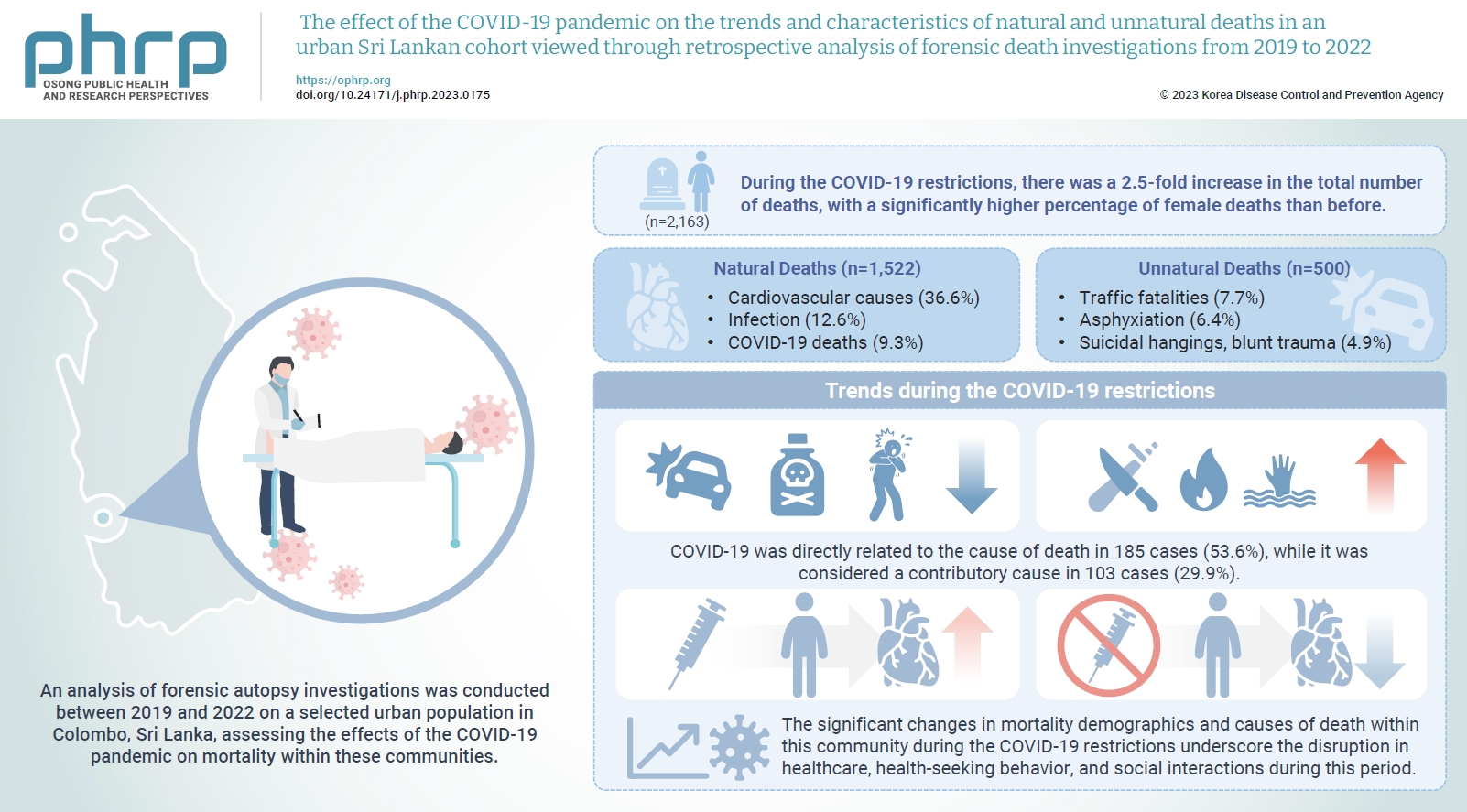Search
- Page Path
- HOME > Search
- The effect of the COVID-19 pandemic on the trends and characteristics of natural and unnatural deaths in an urban Sri Lankan cohort viewed through retrospective analysis of forensic death investigations from 2019 to 2022
- Sameera Anuruddha Gunawardena, Nishani Dassanayake, Buddhika Indeewarie Keerawelle, Shivasankarie Kanthasamy, Hasini Ranganatha, Jayani Wathsala Gunawardana
- Osong Public Health Res Perspect. 2023;14(6):468-482. Published online November 23, 2023
- DOI: https://doi.org/10.24171/j.phrp.2023.0175
- 1,199 View
- 46 Download
-
 Graphical Abstract
Graphical Abstract
 Abstract
Abstract
 PDF
PDF 
- Objectives
The coronavirus disease 2019 (COVID-19) pandemic has had a severe impact on global health. Apart from the disease itself, the strict restrictions and lockdowns enforced to minimize its spread have also substantially disrupted personal and public health. Methods: An analysis of forensic autopsy investigations was conducted between 2019 and 2022 on a selected urban population in Colombo, Sri Lanka, assessing the effects of the COVID-19 pandemic on mortality within these communities. Results: During the COVID-19 restrictions, there was a 2.5-fold increase in the total number of deaths, with a significantly higher percentage of female deaths than before. The majority of these deaths were due to cardiovascular causes, while COVID-19-related deaths ranked third overall. The highest proportion of COVID-19 deaths occurred among unvaccinated females. The monthly frequency of deaths from traffic accidents, poisoning, and asphyxiation decreased, while deaths from blunt trauma, sharp trauma, burns, and immersion increased. There was also a rise in blunt homicides and a greater number of femicides during the COVID-19 restrictions than in the pre-pandemic period. A significantly higher percentage of males who received the COVID-19 vaccine died from cardiovascular causes compared to those in the unvaccinated group. Conclusion: The significant changes in mortality demographics and causes of death within this community during the COVID-19 restrictions underscore the disruption in healthcare, healthseeking behavior, and social interactions during this period. The vulnerability of individuals residing in highly urbanized areas with lower socioeconomic status, particularly women, is brought into sharp focus.
- Risk factors for deaths associated with COVID-19 according to the cause of death classification in Republic of Korea
- Na-Young Kim, Seong-Sun Kim, Hyun Ju Lee, Dong Hwi Kim, Boyeong Ryu, Eunjeong Shin, Donghyok Kwon
- Osong Public Health Res Perspect. 2023;14(2):89-99. Published online April 18, 2023
- DOI: https://doi.org/10.24171/j.phrp.2022.0312
- 1,468 View
- 93 Download
-
 Graphical Abstract
Graphical Abstract
 Abstract
Abstract
 PDF
PDF 
- Objectives
This study aimed to classify coronavirus disease 2019 (COVID-19)-related deaths according to whether COVID-19 was listed as the cause of death, and to investigate the differences in demographic characteristics and risk factors for COVID-19 death classifications.
Methods
A total of 5,625 deaths in South Korea among patients with confirmed COVID-19 from January 20, 2020 to December 31, 2021 were selected. Excluding false reports and unnatural deaths, 5,597 deaths were analyzed. Based on death report data, deaths were classified according to whether the cause of death was listed as COVID-19 (CD) or not (NCD). The epidemiological characteristics and causes of deaths were investigated using descriptive, univariate, and multivariate statistical analyses. Odds ratios (ORs) and 95% confidence intervals (CIs) were calculated to analyze the risk factors.
Results
The case fatality ratio was 0.89% and increased with age. Additionally, 96.4% of the subjects had an underlying disease, and 53.4% died in winter. The proportion of NCDs was 9.3%, of whom 19.1% died at home and 39.0% were confirmed to have COVID-19 after death. Malignant neoplasms (102/416 vs. 637/4,442; OR, 1.71; 95% CI, 1.36−2.16; p<0.001) were significantly associated with NCD.
Conclusion
This is the first study to analyze risk factors by cause of death using COVID-19 death report data in South Korea. These results are expected to be used as evidence for establishing a death monitoring system that can collect timely information in a new infectious disease pandemic.
- Characteristics of Inpatients Who Survive Suicide Attempts
- Sang Mi Kim, Hyun-Sook Lee
- Osong Public Health Res Perspect. 2019;10(1):32-38. Published online February 28, 2019
- DOI: https://doi.org/10.24171/j.phrp.2019.10.1.07
- 5,483 View
- 155 Download
- 3 Crossref
-
 Abstract
Abstract
 PDF
PDF Objectives The purpose of this study was to analyze the characteristics and factors affecting the survival of inpatients admitted following a suicide attempt.
Methods A total of 3,095 cases retrieved from the Korean National Hospital Discharge In-depth Injury Survey data (from 2011 to 2015) were grouped according to survival and death and analyzed using descriptive statistics chi-square and logistic regression analysis.
Results The following factors had statistically significant risks on reducing survival: female (OR = 2.352,
p < 0.001), 40–59 years old (OR = 0.606,p = 0.014), over 60 years old (OR = 0.186,p < 0.001), poisoning (OR = 0.474,p = 0.009), hanging (OR = 0.031,p < 0.001), jumping (OR = 0.144,p < 0.001), conflicts with family (OR = 2.851,p < 0.001), physical diseases (OR = 1.687,p = 0.046), mental health problems (OR = 2.693,p < 0.001), financial problems (OR = 3.314,p = 0.002), 2014 (OR = 2.498,p = < 0.001) and 2015 (OR = 2.942,p = 0.005).Conclusion The survival group that had a history of attempted suicide (high-risk suicide group), should be further characterized. It is necessary to identify the suicide methods and risk factors for suicide prevention management policies and to continuously expand the management policy according to these characteristics.
-
Citations
Citations to this article as recorded by- Factors Affecting Inpatients’ Mortality through Intentional Self-Harm at In-Hospitals in South Korea
Sulki Choi, Sangmi Kim, Hyunsook Lee
International Journal of Environmental Research an.2023; 20(4): 3095. CrossRef - The economic burden of adolescent internet addiction: A Korean health cost case study
Robert W. Mead, Edward Nall
The Social Science Journal.2023; : 1. CrossRef - Loss to follow-up in a population-wide brief contact intervention to prevent suicide attempts - The VigilanS program, France
Larissa Djembi Fossi, Christophe Debien, Anne-Laure Demarty, Guillaume Vaiva, Antoine Messiah, Xenia Gonda
PLOS ONE.2022; 17(3): e0263379. CrossRef
- Factors Affecting Inpatients’ Mortality through Intentional Self-Harm at In-Hospitals in South Korea



 First
First Prev
Prev


